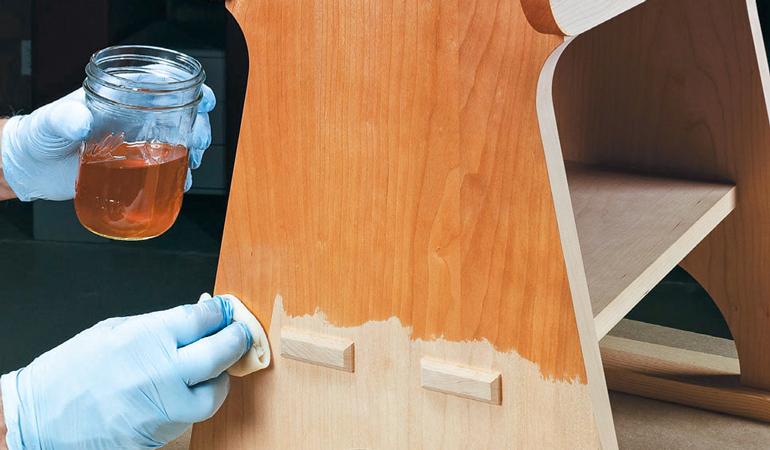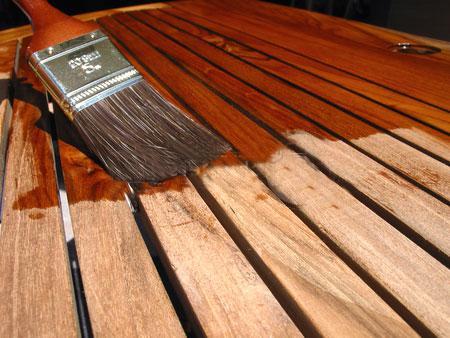
..................................................................................................................................................................
By: Haseeb Jamal
Definition
Varnishes are more or less transparent liquids which are
used to provide a protective surface coating in much the same way as paints do.
At the same time, they allow the original surface to show
but add a lustrous and glossy finish to it.
All varnishes have basically the same components as paints.
What is Varnish?
Varnish is a transparent, hard, protective finish or film
primarily used in wood finishing but also for other materials.
Varnish is traditionally a combination of a drying oil, a
resin, and a thinner or solvent.
Varnish finishes are usually glossy but may be designed to
produce satin or semi-gloss sheens by the addition of "flatting"
agents.
Types of Varnishes
Natural Resin
Varnishes:
Body made from natural resin obtained from certain trees.
Natural resin obtained from living trees or from fossils (which
are superior). Vehicle in varnish is the same as used in oil-based paint.
Resins dissolved in oil ► mixture heated to
temperature (500-600OF) depending on the amount of gloss required.
Oil and natural resin varnish ► OLEO RESINOUS varnish. Thinner and dryers used in varnish are
the same as used in oil based paints
Modified
natural-resin varnishes:
Made from natural resin ► altered by chemical
action.
Common resin is heat treated with glycerin to form a gum.
This gum is treated as the body for the varnish. Less expensive varnish than
the oleo resinous varnish
Synthetic resin
varnish:
· Synthetic varnish
produced by plastic industry
· Chemicals used
include nitrocellulose, amino resins, silicon etc
· Vehicle most often
the same as for oleo resinous varnish
· Coal tar
derivatives may be used as thinners
· Dryer is also the
same as for other types of varnishes
Classification of
Varnishes
1.
Long oil varnish:
· Long oil contain 40
to 100 gal of oil per 100 lbs of resin
· Takes longer time
to dry
· Moderate gloss
· Marine and spar
varnish belongs to this group
· Tung oil used ► impervious to water
2.
Medium oil varnish:
· Medium-oil contain
12 to 40 gal of oil per 100 lbs of resin
· They dry faster ► harder
· Harder film than
long-oil varnish but are not impervious to water
· Floor varnish
belongs to this group
3.
Short oil resins:
Short-oil contain 5 to 12 gal of oil
per 100 lbs of resin. Dry rapidly ► form a hard,
brittle film that withstand much rough usage. Polishing varnish belongs to this
group
Plasters
Overall, it can be stated that the improved element
performed better than the traditional element in the series of earthquake
simulations.
This statement is based on an assessment of the risk of
causing injury posed by each structure. The walls of the traditional corners
were independent and unstable.
Any additional force, such as another tremor or a strong
wind or impact, could cause either wall to topple over, in an inward or outward
direction. This represents an unacceptable level of risk.
These buildings are one of the most deficient building
systems from earthquake-resistance point
of view.
The main deficiencies include excessive wall thickness,
absence of any connection between the two withes of the wall, and use of round
stones (instead of shaped ones).
Distempers
They are paints used for the treatment of masonry walls.
Water instead of oil is used as a vehicle ► known as
water-paint too.
Powdered white chalk and glue boiled in water are mixed.
Usually colored by mixing different pigments.
All Distempers mixed with water only before being used.
Distemper affected by weathering condition and takes off if washed ► to be used only in interior works.
Cheap, durable and easy interior finish. Should be applied
on clean and dry surface.
Haseeb
Jamal. I am a Civil Engineer,
graduated from University
of Engineering and Technology, Peshawar, Pakistan in 2010. I also
have a PG-Diploma in Disaster Management and
MS in Urban
Infrastructure Engineering (In Progress). My expertise include civil
related softwares like AutoCAD,
SAP2000, MS Project, Primavera, MS Office and GIS. My technical skills include
project management, monitoring and evaluation, structural assessment, disaster
risk management, Quantity survey, land survey, material testing, site
management and technical writing. I am trained in writing project progress
reports as well as proposals and concept papers. I have also received advanced training
on surveying, proposal writing, Monitoring and Evaluation of projects as well
as organizations.
I have worked as Project Engineer at
National Research and Development Foundation, Peshawar and CENCON Associates. I
also worked with Spectra Engineering Solutions as Senior Civil Engineer in
monitoring of World Bank and UNDP funded projects all over Khyber Pakhtunkhwa
and FATA. Currently, I am working as Deputy Manager Development at
NayaTel, Peshawar.



No comments:
Post a Comment